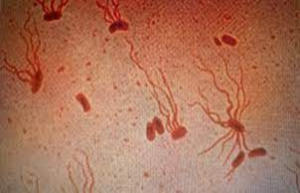Please click the frequently asked questions below for further information and IPC precautions required:
-
What is Typhoid Fever?
Typhoid fever is a systemic infection caused by the gram-negative bacterium Salmonella typhi.
Typhoid fever is very rare in the UK and most cases are imported due to foreign travel to countries where typhoid fever is endemic, or contact with someone who has travelled. Vaccination is available for those who live or travel to endemic areas where the risk of typhoid fever is high.

-
Why is this information important?
If NIAS staff are aware that the patient is potentially symptomatic or a confirmed case of Typhoid Fever then this should be communicated to EAC / NEAC and the receiving unit when transferring the patient to ensure effective patient care and management.
This is a notifiable condition to Public Health Agency (PHA).
-
How is it spread?
Transmission occurs through the ingestion of food or water that is contaminated with faeces. Direct faecal-oral transmission can also occur.
Person-to-person spread of Typhoid is uncommon but can be transmitted if direct contact with contaminated vomit or feaces.
Patients should continue to be considered infectious while symptomatic and for 48 hours after resolution of symptoms.
-
What are the symptoms of Typhoid?
Symptoms usually includes:
- Diarrhoea
- Muscle aches
- Headache
- Mild Fever
Severe disseminated disease with multi-organ involvement in 10-15% of cases. The fatality rate is less than 1% with prompt antibiotic treatment but may be as high as 20% if left untreated.
-
IPC Precautions
- Contact precautions should be used.
- Hand Hygiene should be completed as per the 5 moments in line with usual practice with Soap and Water
- Eye protection should be risk assessed and worn if any risk of splashes.
- Gloves and Aprons should be worn.
- The patient should be transported via ambulance with no other patients present.
- Laundry should be treated as contaminated, placed into an alginate bag and placed into a red laundry bag.
-
What cleaning is required?
All equipment and the ambulance should have an in-between patient clean, paying particular attention to touch points.
-
Do staff need any prophylaxis or follow up?
If staff have been exposed to a confirmed or suspected case of Typhoid Fever they should remain vigilant for any symptoms but there is no active follow up required.
If staff become symptomatic they should remain off work until 48 hours asymptomatic (72 hours if food handling).




